Lower Not Lift
In the latest Rundown, research looks at workouts and poor sleep, online diagnostics enter the fitness space and why lowering weights may be all you need to do.
The Rundown
Sleepy Workout. How do you get the most out of your workout when you’ve had a bad night’s sleep? In a new study, Australian researchers suggest that if you’re exercising on little sleep, you get the most benefit from doing it earlier in the day and focusing on strength and endurance.
Published in Sports Medicine, the meta-analysis looked at data from 77 studies to examine the impact of one night of bad sleep (fewer than six hours) on endurance, strength and athletic skill the next day.
The team used a percentage scale to study each exerciser’s performance. They found that after a night of poor sleep, complex skills like hitting a tennis ball declined by as much as 23% while strength and endurance only had losses of up to 5% and 8% compared to workouts after a full night’s sleep.
The researchers also found that exercising just after waking up helped lessen the effects of sleep loss. If a workout was done in the morning, performance on complex skills dropped by 14%. If it was done in the evening, it dropped 23%. A similar outcome was observed in weight lifters. Those who did a morning workout performed 2% worse. In the evening, they performed 5% worse.
The reason for the performance shift between morning and evening is related to the body’s circadian rhythm. We naturally feel more alert when it’s light outside and more tired when it’s dark. This is because the body releases adrenaline in response to morning light. In addition, a chemical called adenosine, which creates a sleepy feeling, is usually lowest in the body just after waking up and increases as the day goes on.
DIY Fitness Tests. If you’re interested in testing that offers a deep dive into your health and overall fitness, Quest Diagnostics has just introduced three new fitness panels to their online platform.
If you’re unfamiliar with it, Quest’s website allows you to buy and schedule lab tests without seeing a doctor. The results are delivered directly to you. You can share them with your doctor or connect with an independent physician through Quest and PWNHealth services to have a one-on-one discussion and review your results.
For the new fitness panels, you can choose from three profiles: Essentials, Nutrition and Elite. The Essentials Profile checks for markers of general health, macro and micronutrients, hydration and electrolytes, endurance and recovery. The Nutrition Profile evaluates adequate nutrition and identifies nutrient deficiencies. The Elite Profile targets top athletes who train at high volumes. This profile offers performance insights for susceptibility to overtraining or tapering training that can lead to higher performance levels.
Lower Not Lift. Why lift and lower weights when you can just lower them? That’s the idea behind a recent study that shows eccentric muscle contractions or lowering a weight is more important to increasing strength and size of muscles than concentric (lifting) or isometric (holding) contractions.
For the study, three training groups—one that only lowered weight, one that only lifted weight and one that lifted and lowered weight—did dumbbell curls twice a week for five weeks. All three groups saw improvements in concentric (lifting) strength. But this was the only improvement for the lifting weight group.
The lowering weight group and the group that did both lifting and lowering had improvements in static strength and eccentric (lowering) strength.
The most interesting results were that the lowering-only group had very similar gains to those lifting and lowering weights despite doing half as many reps. This group also saw a bigger improvement in muscle thickness.
Study author, Professor Kazunori Nosaka offers some tips to put the research into practice. With a dumbbell, he recommends using two hands to help with the lifting weight phase then use one arm for the lowering weight phase when performing bicep curls, overhead extension, front raise and shoulder press. He adds, “Understanding the benefits of eccentric-focused training can allow people to spend their time exercising more efficiently.”
Replay
This week’s vintage moment in fitness culture is brought to you by a quick workout at the office, 1970’s style. Photo: Keystone-France/Getty Images.




